How to Read Usda Soil Textural Triangle
seven Soil Texture and Structure
Soil texture and construction are considered "master variables", meaning that texture and structure direct influence a large number of other soil properties. For case, in comparison a clayey soil and a sandy soil, ane would expect the clayey soil to have larger specific surface surface area, more cation exchange chapters, more full porosity, less macroporosity, and more organic matter than the sandy soil. Thus, past simply knowing the texture of the soil, inferences can be made in regard to many soil properties. Here, soil texture will be determined quantitatively using the hydrometer method, and estimated using the texture past feel method. Different soil construction types volition also exist observed. What you learn almost texture and structure in these activities will be used after during the soil pit field trips to describe soil profiles in the field.
- Differentiate the iii soil separates (sand, silt, and clay) based on their particle size diameters.
- Make up one's mind the percentages of sand, silt, and dirt in selected soil samples using data nerveless from the hydrometer method of particle size analysis.
- Estimate the textural class using the texture-by-feel method on selected soil samples.
- Employ a textural triangle to determine the textural class of a soil.
- Empathize the relationship between particle size and specific surface area.
- Three soils of known textures
- Sodium hexametaphosphate
- Squirt bottles filled with tap water
- Lab balances accurate to the nearest 0.01 grand
- Soil test cylinders, 1L volume (Item #200231000, Kimble ™ Kimax™ Soil Test Cylinders)
- Hydrometers calibrated in units of g/L (Detail #13-202-133 Fisherbrand™ Soil Analysis ASTM Hydrometer)
- Digital thermometers accurate to the nearest 0.1°C
- Milkshake mixers and stainless steel milk shake mixer cups (Hamilton Embankment HMD400 120V Triple Spindle Commercial Drink Mixer, Hamilton Beach, Glen Allen, Virginia, U.Due south.)
Using the recommended reading and viewing resources and the introduction to this lab, consider the questions listed beneath. These definitions/questions will provide a concise summary of the major concepts to exist addressed in the lab. They will also serve every bit the basis for the post-lab quiz and are useful study notes for exams.
- Define and explain the departure betwixt soil texture and soil construction.
- List the sizes for sand, silt, and clay particles using USDA criteria.
- What is a textural triangle?
- What is Stoke'due south Law and how is it used in soil science?
- Define specific surface expanse and explicate its human relationship to size of soil particles.
Introduction
Soil texture refers to the proportions of sand (2.0 – 0.05 mm in diameter), silt (0.05 – 0.002 mm), and clay (less than 0.002 mm). The relative proportions determine the textural grade. Soil texture influences most every attribute of soil use and direction. Many of the physical and chemical properties of the soil depend on how fine (clayey) or coarse (sandy) a soil is. Soil texture is a permanent feature unless soils are subjected to rapid erosion, deposition, or removal.
Moreover, much of the reactivity of soils is related to the amount of surface area available. As the average particle size decreases, the expanse per unit weight increases (see Table seven.ane).
Table 7.ane. Surface areas of soil particle sizes.
| Seperate | Bore (mm) | Particles/g | Specific surface expanse (cm^2/g) |
|---|---|---|---|
| Very course sand | 2.00 - 1.00 | xc | 11 |
| Coarse sand | 1.00 - 0.50 | 720 | 23 |
| Medium sand | 0.fifty-0.25 | v,700 | 45 |
| Fine sand | 0.25-0.10 | 46,000 | 91 |
| Very fine sand | 0.10-0.05 | 722,000 | 277 |
| Silt | 0.05-0.002 | 5,776,000 | 454 |
| Clay | < 0.002 | 90,260,000,000 | viii,000,000 |
Table from Rex et al. (2003).
Nearly whatever blazon of country management will be influenced past texture. Tabular array vii.2 provides a summary of soil management factors related to texture.
Tabular array vii.two. Summary of soil texture relationships to diverse soil physical and chemical properties.
| Water relations | Sandy soils | Loamy soils | Clayey soils |
|---|---|---|---|
| Infiltration—entry of surface water into the soil. Reverse of run-off potential | Rapid | Medium to tiresome | Very rapid if cracks present; slow if no cracks |
| Percolation—internal water drainage and leaching | Excessive | Good | Fair-Poor |
| Water Storage—bachelor for constitute use | Very depression | Medium | High |
| Aeration—movement of oxygen into root zone | Very skillful | Moderate | Poor |
| Tillage and Erosion Cultivation ability required | Low | Medium | High |
| Tillability—ease of seed-bed training | Easy | Medium | Difficult |
| Erodibility Air current erosion hazard | High | Low | Medium |
| Water erosion risk | Low | High | Low to medium |
| Chemical Relations Fertility potential (nutrient storage) | Low | Medium | High |
| Chemic Recommendations—rates per acre | Low | Medium | Loftier |
Table from King et al. (2003).
Activity 1: Textural Triangle
Soils with similar distributions of sand, silt, and clay accept similar properties and are therefore grouped into the same soil textural grade. Twelve textural classes are recognized, and their compositions are designated on a textural triangle (Figure 7.1). Study the arrangement of the triangle. Each corner represents 100% of either sand, silt, or dirt, and each represents 0 to 100% of a given fraction. The proportions of sand, silt, and dirt define the twelve classes. Effigy vii.1 depicts a soil with 20% sand, 25% silt, and 55% clay. Those three lines intersect inside the boundaries of the "Dirt" textural class, and so the soil is a clay soil.
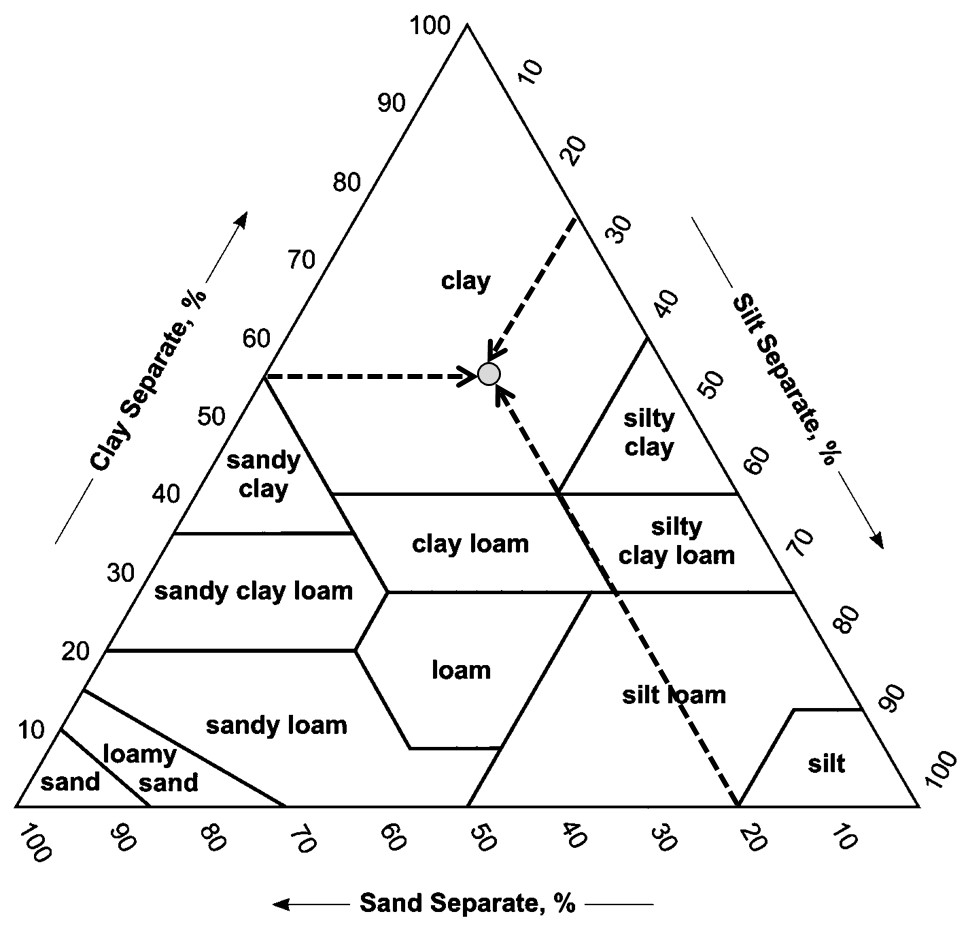
![]() Using that same procedure, determine the textural form names for the soils described in Table seven.3, and plot each result on the textural triangle in Effigy 7.two.
Using that same procedure, determine the textural form names for the soils described in Table seven.3, and plot each result on the textural triangle in Effigy 7.two.
Table 7.three. Soil Texture Form Action
| % Sand | % Silt | % Clay | Textural Form | |
|---|---|---|---|---|
| 1. | 33 | 33 | 34 | |
| 2. | 55 | 30 | 15 | |
| 3. | fourscore | 5 | 15 | |
| 4. | 25 | threescore | 15 | |
| 5. | - | 20 | l | |
| half dozen. | threescore | - | 30 | |
| 7. | 40 | 40 | - |
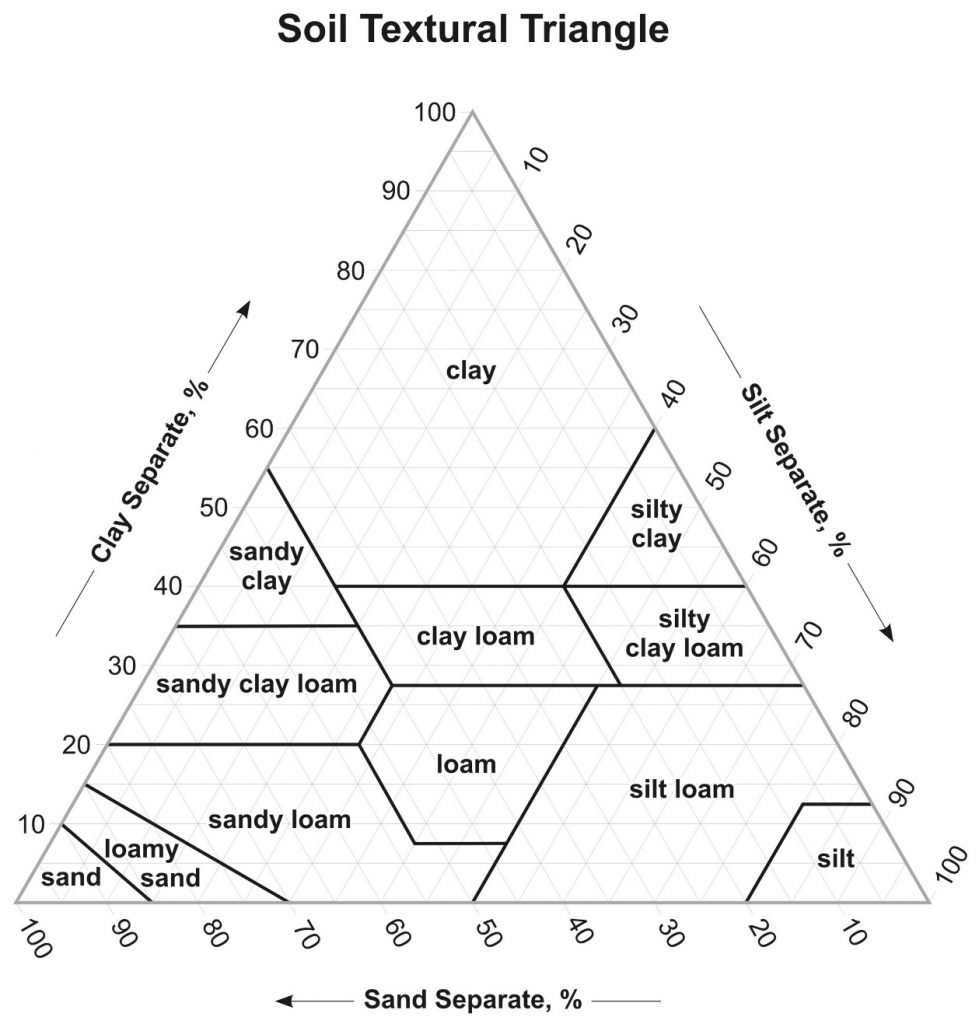
Activity 2: Estimating Soil Texture by Feel
A soil scientist often needs to guess soil texture while in the field or when laboratory data on the amounts of sand, silt, and clay are not bachelor. With practice, you can learn to estimate texture by but feeling or manipulating a moist sample.
To learn this technique, consider a simplified and generalized version of the textural triangle (Fig. 5.3). This modified triangle consists of three tiers based on gauge clay content. Clays are very cohesive, plastic, and can be easily molded. Clay loams are intermediate in clay content, cohesiveness, and ease of molding. Loams are soils low enough in clay content to possess little cohesiveness and are more than difficult to mold. Sands exercise not form stable forms when molded.
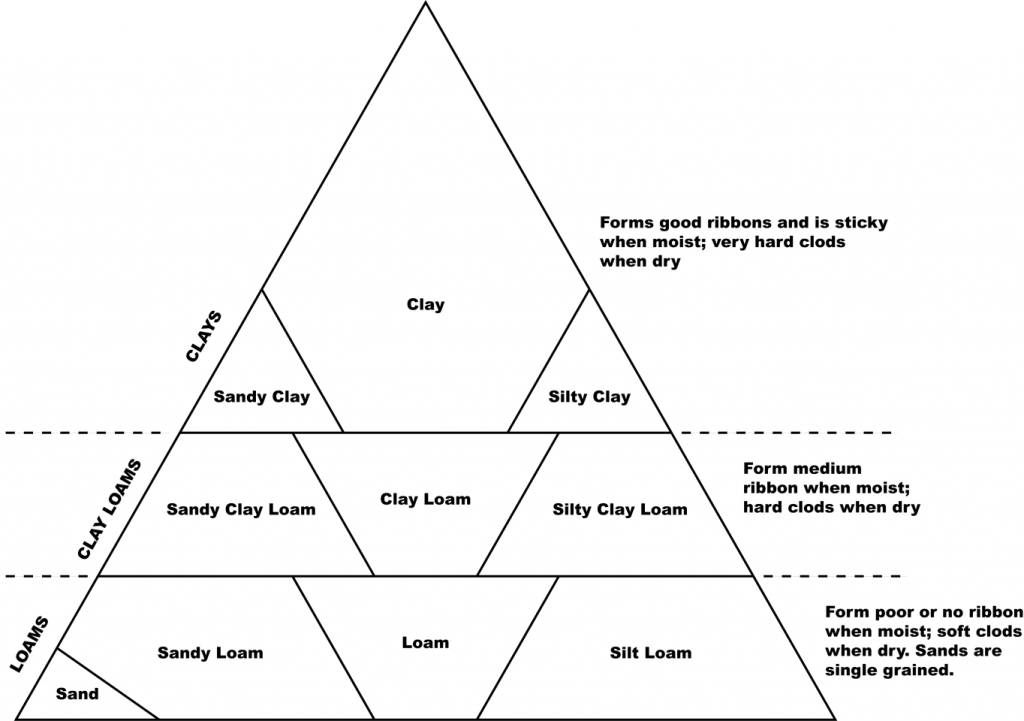
Using the procedure outlined in Figure 7.4, determine the texture on the samples provided in the laboratory. Working the sample at the proper moisture content is very important. The sample must be moistened throughout. Achieving the right wet condition may take several minutes. Afterward moistening and mixing soil to the proper consistency, perform the ribbon test, the grittiness examination, and the smoothness exam as described in the diagram. Try to approximate the texture of the samples, and so cheque the answers provided. After you have calibrated your fingers on the practice samples, decide the texture for the unidentified samples provided, and enter your estimate in Table 7.3.
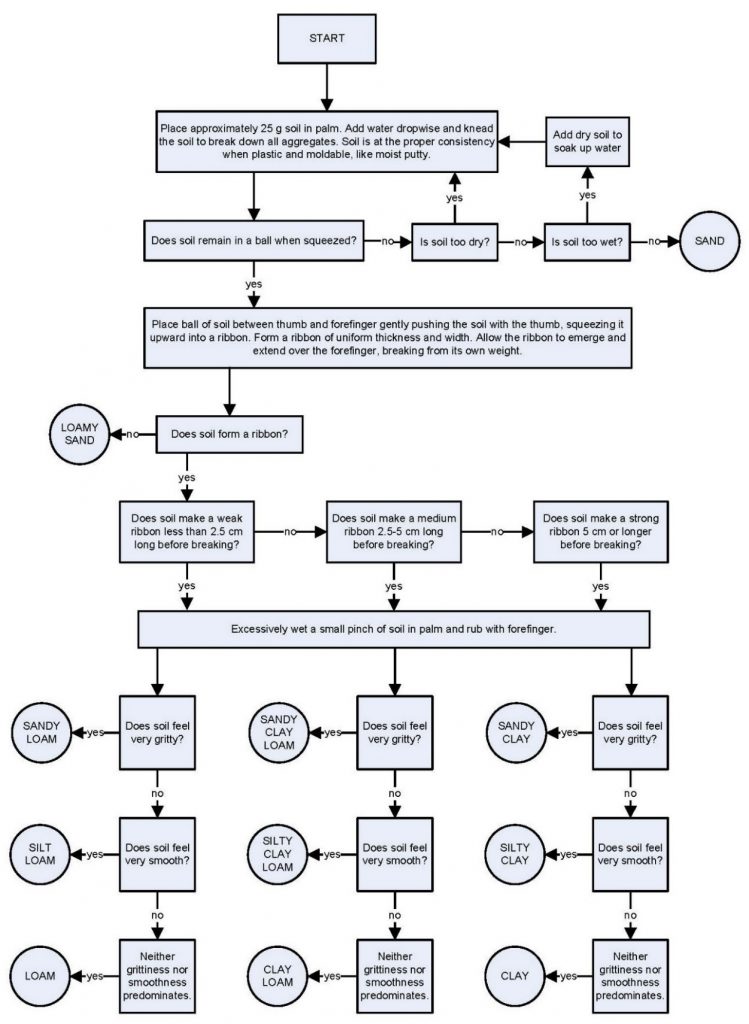
![]() For the unidentified samples, record the ribbon length, predominant wet experience (smooth, gritty, neither), and textural class names determined past the feel method shown in Tabular array 7.3.
For the unidentified samples, record the ribbon length, predominant wet experience (smooth, gritty, neither), and textural class names determined past the feel method shown in Tabular array 7.3.
Table 7.4. Results for estimation of soil texture by experience.
| Does is brand a brawl? | Does it make a ribbon? | Ribbon Length | Predominate Wet Feel | Textural Course | |
|---|---|---|---|---|---|
| ane. | |||||
| 2. | |||||
| iii. |
Table from Male monarch et al. (2003).
Action 3: Particle Size Analysis by Hydrometer
Particle size analysis is based on the principle that different size particles fall through a fluid at different rates.
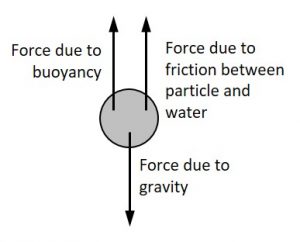
A particle falling in a fluid is subjected to three forces: gravity, buoyancy, and friction (Effigy 7.5). The gravity and buoyancy forces are constant, but the frictional force increases as the velocity increases (like the elevate force on an airplane increases as it goes faster). Because of this increasing frictional force, the particle eventually reaches a constant velocity (last velocity). Constant velocity occurs when the sum of the forces acting on the particle is zero, or acceleration is nil.
Stoke's Police is derived by setting up an equation containing the three forces interim on the particle when acceleration is zero:
[latex]\text{Force of gravity }=\text{ forcefulness of buoyancy }+\text{ force of friction}[/latex]
These forces are determined from the following relationships:
Forcefulness of Gravity
[latex]\text{Forcefulness of gravity }=\text{ mass of particle }\times\text{ acceleration of gravity}[/latex]
[latex]\text{Mass of particle }=\text{ Book of particle }\times\text{ density of particle}[/latex]
Therefore,
[latex]\text{Force of gravity }=\text{ volume of particle }\times\text{ density of particle}\times\text{ acceleration of gravity}[/latex]
Force of Buoyancy
[latex]\text{Force of buoyancy }=\text{ mass of h2o displaced past particle }\times\text{ acceleration of gravity}[/latex]
[latex]\text{Mass of displaced h2o }=\text{ volume of particle }\times\text{ density of h2o}[/latex]
Therefore,
[latex]\text{Force of buoyancy }=\text{ volume of particle }\times\text{ density of water}\times\text{ acceleration of gravity}[/latex]
Friction Force
Friction force is a office of the size of the particle, the velocity of the particle, and the viscosity of the water.
[latex]\text{Friction force }=6π\times\text{ viscosity }\times\text{ radius of particles}\times\text{ velocity}[/latex]
Afterwards substituting the appropriate components of the forces into the equation, it can be solved for the last velocity:
[latex]\text{Velocity }=\frac{\text{ particle diameter}^two\times\text{ dispatch due to gravity}\times(\text{ particle density}-\text{ liquid density})}{18\times\text{viscosity of liquid}}[/latex]
Note that the larger the diameter of the particle, the faster it settles (sand grains volition settle faster than silt particles, which volition settle faster than clay particles). Also, the density and viscosity of water vary with temperature, so the velocity of settling volition be influenced by the temperature of the h2o (Figure 7.6).
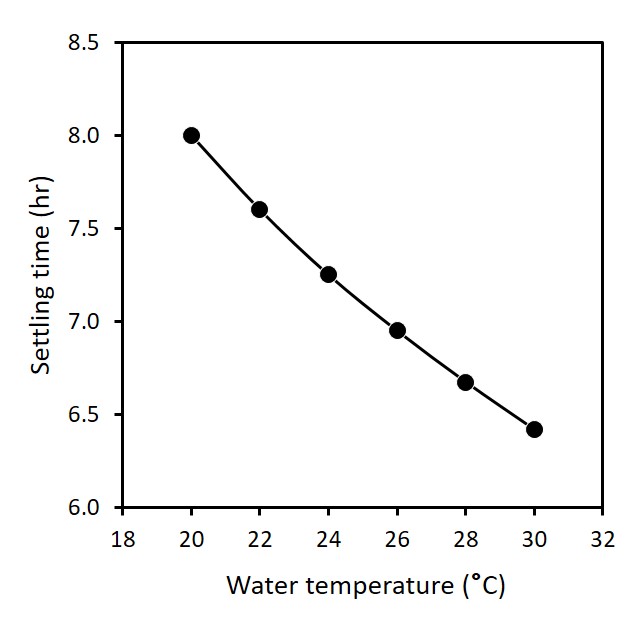
Stoke'due south Police force can exist simplified by specifying the temperature of the water:
[latex]\text{Velocity }(\text{cm s}^2)=\text{K}\times(\text{diameter of particle in cm})^2[/latex]
Where G (cm-1 s-1) is a constant incorporating water density and viscosity and acceleration due to gravity. Considering velocity is distance/time, this equation tin be solved for time required for a particle of a specified diameter to fall a given distance.
[latex]\text{Velocity }=\frac{\text{altitude}}{\text{time}}=\text{K}\times(\text{diameter})^2[/latex]
Therefore,
[latex]\text{Time}=\frac{\text{distance}}{\text{Chiliad}\times(\text{bore})^two}[/latex]
Thus, for a particle of a given diameter, the time required for the particle to autumn a specified distance can be calculated.
Consider this example: How long volition it take a 0.05-mm particle to fall 10 cm in water at 25°C?
At 25°C, K = 10,000 cm-1 s-1. Substituting this value and the diameter (0.005 cm) into the above equation yields:
[latex]\text{Time}=\frac{10\text{ cm}}{10000\text{ cm}^{-1}\text{ s}^{-one}\times(0.005\text{ cm})^two}=\frac{ten}{0.25\text{ cm south}^{-1}}=40\text{southward}[/latex]
Thus, later on xl seconds, the upper 10 cm of a soil-h2o suspension is completely gratuitous of all particles 0.05 mm or larger, so it is free of sand and contains simply silt and clay.
Allow's practice the same calculation for a 0.002-mm particle, which is the upper limit of the clay range.
[latex]\text{Time}=\frac{10\text{ cm}}{10000\text{ cm}^{-one}\text{ south}^{-one}\times(0.002\text{ cm})^two}=\frac{10}{0.0004\text{ cm southward}^{-1}}=half-dozen.94\text{hr}[/latex]
Thus, subsequently 6 hours and 56 minutes, the upper x cm of a soil-h2o intermission is complimentary of all particles 0.002 mm or larger (sand and silt), so it contains only dirt particles.
As we can run across, Stokes Police force tin can exist used to make up one's mind when a volume of a soil-h2o intermission will be devoid of soil particles larger than a given size. Then we can measure the concentration of soil remaining in that book. For example, after 40 seconds, we tin can measure the concentration of soil in break in the upper 10 cm of a suspension and thus make up one's mind how much clay + silt are present.
Under natural conditions, sand, silt, and clay particles are bound together in aggregates. These aggregates must be broken down so soil particles act independently of each other. For instance, an aggregate of clay particles would conduct every bit a silt particle, a phenomenon we want to avoid.
Dispersion is a 2-step, chemical/mechanical process. First, sodium hexametaphosphate (like the dishwashing detergent "Calgon®") is added to a soil-water suspension to increase electronegativity of soil clays; it causes a repulsive force between clay particles. Then the intermission is stirred vigorously (milkshake mixer or blender) to assure consummate dispersion. The repulsive forces generated by the chemical treatment tend to stabilize the dispersed condition. Dispersion thus assures that aggregated clay particles do not behave like silt-sized or sand-sized particles.
Soil organic affair is an important binding amanuensis, so information technology first must be removed by oxidation (using hydrogen peroxide, for example). In soils with very low in organic matter, this pace is often omitted. Information technology will not be used in this exercise.
Afterwards proper dispersion, sand, silt, and clay can be separated and quantified by assuasive the particles to settle in water. (Note: a sieve is commonly used to quantify sand content of a soil sample, and then a hydrometer to quantify silt and clay content of the remaining particles. Nosotros volition use a hydrometer for all iii particle sizes in this lab activity.)
One method of determining the concentration of soil in suspension is using a hydrometer to measure the density of the break. The hydrometer is unremarkably used in field labs. In this exercise, nosotros'll use a hydrometer calibrated to read directly in g/L of break.
Simplified Hydrometer Process
Chemical dispersion (performed in the previous lab)
- Weigh out xxx.0 thousand of dry soil (assume oven-dry) into a 250-ml Erlenmeyer flask.
- Wash sides of flask with distilled water from a wash canteen.
- Add 100 ml of distilled water using a graduated cylinder, and add 10 ml of sodium hexametaphosphate solution (500 grand/Fifty) from the dispenser on the sodium hexametaphosphate canteen.
- Swirl to mix.
- Wash sides of flask with distilled h2o from a launder bottle.
- Cover the flask with Parafilm and label the flask with your lab section and table number as well every bit soil blazon. Shop the flasks in the location specified past your instructor until next laboratory period.
Afterward chemical dispersion
- Quantitatively transfer the dispersed sample into a metal dispersion cup (a milkshake mixer loving cup), make full to one-half total with distilled water, and mix for 5 minutes equally directed past your instructor. ("Quantitatively transfer" means to transfer all the sample.)
- Quantitatively transfer the sample into a ane-liter sedimentation cylinder.
- Fill cylinder to the one thousand-ml mark with distilled water.
- Suspend all soil particles in the sedimentation cylinder using ane of the post-obit methods:
- Plunger method: Carefully insert stirring plunger and move up and down the full length of the cylinder for 30 seconds, ensuring that all particles are thoroughly mixed. Concur base of operations of cylinder firmly with other hand.
- Stopper method: Identify a safe stopper (one properly sized for the sedimentation cylinders) into the top of the cylinder, and property both the lesser of the cylinder and the peak of the stopper, mix the solution vigorously by inverting the cylinder and turning it right side upwardly repeatedly for xxx seconds.
- Record time when stirring is stopped and plunger removed, or when the stoppered cylinder is returned (speedily just gently) correct-side-upwardly to the laboratory bench.
- Immediately insert the hydrometer slowly and carefully. Read the hydrometer (pinnacle of the meniscus) at exactly 40 seconds later on stirring was stopped or the cylinder was returned to the bench. (Notation: if a soil is high in organic matter that was not removed before beginning this experiment, bubbles will class at the surface. To disperse the bubbles, add three to five drops of alcohol to the surface of the solution immediately later inserting the hydrometer.
- Repeat steps iv through 6 until readings are within 0.5 units of each other. Record the reading on the data sheet.
- Decide the temperature of the suspension and brand corrections for temperature and for the blank as described in Tabular array 7.4:
- For each degree above 20°C, add 0.36 to the hydrometer reading.
- For each degree beneath 20°C, subtract 0.36 from the hydrometer reading.
- Because the soil suspension also contains sodium hexametaphosphate, each hydrometer reading must exist corrected to account for the result of sodium hexametaphosphate on density. A "blank" cylinder has been set up containing merely water and sodium hexametaphosphate. Record the hydrometer reading from this cylinder and subtract that value from all hydrometer readings.
- Your lab teacher has conducted measurements for the vii-60 minutes reading and will provide the data to you to complete your soil texture conclusion.
- Calculations:
Retrieve that these hydrometer readings are in g/L. Because the book in the cylinder is one liter, the readings gives the amount of soil in the cylinder. For example, the 7-hour reading indicates the amount of dirt (grand) in the cylinder. Therefore, the per centum clay is
[latex]\text{Percent dirt}=\frac{\text{corrected 7 hr reading}}{\text{mass of dry sample}}\times100%[/latex]
The twoscore-2nd reading is used to calculate percentage silt + dirt:
[latex]\text{Per centum silt }+\text{ dirt}=\frac{\text{corrected 40 s reading}}{\text{mass of dry out sample}}\times100%[/latex]
Then the silt and sand percentages tin can be adamant.
[latex]\text{Percentage silt }=(\text{percent silt}+\text{percent clay})-\text{percent dirt}[/latex]
[latex]\text{Percent sand }=100-(\text{percent silt}+\text{percentage dirt})[/latex]
![]() Use Table 7.4 to help make up one's mind the textural class of your samples. Label all results in the proper units.
Use Table 7.4 to help make up one's mind the textural class of your samples. Label all results in the proper units.
Table 7.5. Soil Texture by Hydrometer Method Data.
| Row | Formula | Soil A | Soil B | Soil C | |
|---|---|---|---|---|---|
| a | Dry weight of soil, one thousand | ||||
| b | Boilerplate of xl-second hydrometer readings | ||||
| c | Hydrometer reading from blank | ||||
| d | b-c | Hydrometer reading corrected for blank | |||
| e | Temperature of suspension, first readings | ||||
| f | d + [(e - 20) ten 0.36] | 40-second hydrometer reading corrected for temperature | |||
| g | 7-hour hydrometer reading | ||||
| h | Hydrometer reading from blank | ||||
| i | chiliad-h | Hydrometer reading corrected for bare | |||
| j | Temperature of suspension, 2d reading | ||||
| k | i + [(j - 20) ten 0.36] | 7-hour hydrometer reading corrected for temperature | |||
| l | f ÷ a ten 100 | Per centum silt + clay | |||
| yard | one thousand ÷ a 10 100 | Pct dirt | |||
| due north | l-m | Percent silt | |||
| o | 100 - m - northward | Percentage sand | |||
| Textural course (from triangle) |
Table adjusted from Male monarch et al. (2003).
Soil Texture past Hydrometer Method Calculations
Activity 4: Soil Structure
Table 7.6. Summary of soil structure types described in mineral soils.
| Structure Type | Amass Description | Usual Location |
|---|---|---|
| Granular | Relatively nonporous, small and spheroidal peds; not fitted to bordering aggregates | A horizon |
| Platy | Aggregates are plate-similar. Plates often overlap and impair permeability. | E horizon |
| Angular blocky | Block-like peds bounded by other aggregates whose abrupt angular faces form the cast for the ped. The aggregates often break into smaller blocky peds. | B horizon |
| Subangular blocky | Cake-similar peds bounded by other aggregates whose rounded subangular faces form the bandage for the ped. | B horizon |
| Prismatic | Column-like peds without rounded caps. Other prismatic aggregates form the cast for the ped. Some prismatic aggregates break into smaller blocky peds. | B horizon |
| Columnar | Column-like peds with rounded caps divisional laterally by other columnar aggregates that form the cast for the peds. | B horizon in brine soils |

Advisedly examine the different construction types listed in Table 7.6 and shown in Figure 7.seven, then answer the following questions.
![]() How does blocky structure affect permeability of clayey soils?
How does blocky structure affect permeability of clayey soils?
![]() How would a structureless massive status bear upon permeability?
How would a structureless massive status bear upon permeability?
![]() How would manipulation (such equally tillage) of a wet clayey soil affect construction?
How would manipulation (such equally tillage) of a wet clayey soil affect construction?
A quiz will exist available online. Please access it as directed by your teacher.
Source: https://kstatelibraries.pressbooks.pub/soilslabmanual/chapter/soil-texture-and-structure/
0 Response to "How to Read Usda Soil Textural Triangle"
Post a Comment